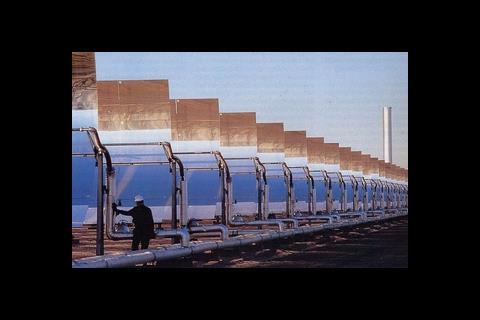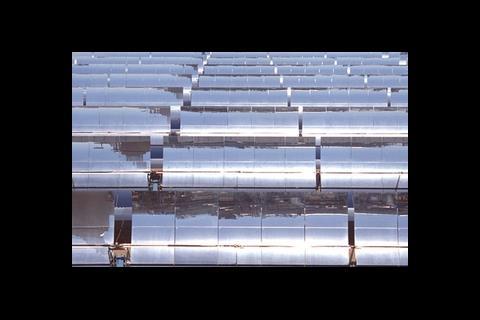‘Solar factories’ in North Africa could soon be supplying electricity to Europe – but only to countries with more pro-active governments than the UK
Electricity is our fastest growing carbon problem, aviation excepted. The means of generation, distribution, storage and use all need to be addressed afresh. The government’s efforts, through the Building Regulations, to improve the thermal performance of new buildings, are completely at odds with its disregard of the use of electrical energy. They have resulted in ever-diminishing returns on investment, and there are far better ways of investing in energy saving.
Causes of increases in electrical use this century include gas-plasma televisions (LCD are much better), portable cooling units (available from DIY stores), stand-by electricity and the move from analogue to digital radio, which uses several times the energy and seems to be progressing without anyone batting an eyelid.
For new buildings at least, this growth in electricity use could be countered by defining carbon zero homes as those for which on-site generation would be required. Unfortunately, unlike heating, the options are very limited, the most common ones being photovoltaic panels and wind turbines. However, the viability of such devices is very sensitive to location. A recent BRE report showed that turbines in built-up areas of London or Manchester only produced about a twentieth as much energy as an identical one in Wick in north-east Scotland. This should not have surprised mechanical engineers. Wind obeys the “cube-rule”, whereby the energy increases in proportion to the cube of the increase in wind speed. If the wind speed doubles, the power increases eight-fold.
Globally, the best renewable resource is solar energy. North Africa receives about three times the solar energy of the UK. Every year each square kilometre of hot deserts receive solar energy equivalent to 1.5 million barrels of oil (about 240 million litres). Solar factories can tap into this using concentrated solar power (CSP) plants. These are quite different from photovoltaics, and use mirrors to concentrate sunlight to create heat which is used to raise steam to drive steam turbines and electricity generators. An area of just 127km x 127km covered with CSP plants would produce as much electricity as Europe is using now.
Two German scientists, Dr Gerhard Knies and Dr Franz Trieb, calculate that just 0.5% of the world’s hot deserts, if covered with CSP plants, could generate as much electricity as the world now uses. One square mile of desert will generate as much electricity as 100 square miles of biofuel crops.
Electricity could be distributed from Africa all around Europe using a high voltage direct current (HVDC) super-grid. HVDC only loses about 3% power per 1000km, and the loss of energy between North Africa and London would be less than 10%. This compares with losses of 50% to 70% for HVAC. HVDC grids do not need to replace HVAC grids, but may be phased in, akin to upgrading road networks.
Renewable energy firm Airtricity proposes laying HVDC cables under the sea from Africa and around Europe. This could avoid a lot of the planning problems with associated delays and could at least form part of the final mix.
All these systems use mirrors and a lot of glass, but glass is made from sand and a lot of heat. Both are plentiful in hot deserts! A spin-off is that after the steam in a CSP plant has done its work in driving the turbines, it is still quite hot. Like any other thermal power plant, that waste heat needs to be removed. If sea water is used for cooling, the waste heat may serve to create fresh water by desalination. The shaded areas under solar mirrors have many potential uses including horticulture using the desalinated sea water.
Countries embracing the idea
The governments of Spain, Morocco, Algeria and Egypt are proceeding with a number of plants. A large CSP plant is planned south of Cairo, to supply 200,000 homes. The German government and Dutch parliament have confirmed support for the Desertech proposal to import electricity from solar energy in Africa.
Other supporters include President Sarkozy of France, Jonathon Porritt of the Sustainable Development Commission, the Climate Change group, Friends of the Earth, Greenpeace and Al Gore (see www.ted.com/talks/view/id/243 ). Meanwhile, the UK government looks set to embark on new nuclear power stations and a series of coal power stations.
The case for a super-grid is particularly compelling for the UK. We could meet most of our electricity demands from (in order of magnitude), wind, waves and tidal energy. Our best resources are off the coasts of Scotland and Northern Ireland, so need efficient transmission to serve our main population centres. The wind and waves are normally strongest in the winter, when solar energy is at its weakest. This fortuitous blend could minimise any need to store energy or fall back on fossil fuels. A shortfall in any one area could normally be met by spare capacity in one or more other areas. For the UK, the super-grid will facilitate the export of our renewable electricity.
The cost/kWhr is less than nuclear power (which has benefited from hidden subsidies), and, as its price equates to about $60/barrel, is now far cheaper than oil. It is still more expensive than gas, but a lot depends upon the price one puts on carbon. Many commentators, including Sir Nicholas Stern, have recommended that the social cost of carbon should be about three times the figure of £25.50/t which Gordon Brown set in December 2007. Coal may be cheaper, but without carbon sequestration technology, would be by far our dirtiest fuel in terms of carbon emissions.
The complementary technologies involve different areas of expertise and it is the role of governments rather than private companies to support them. The UK government’s lack of leadership, and reliance on a competitive energy sector, militate against such an holistic and cooperative approach. This is evidenced by the recent news that Shell is withdrawing from the large Thames estuary windfarm scheme. Reasons cited include uncertainty about government policy which has not enabled sufficient preparation and research.
As Tony Juniper of Friends of the Earth has said, “The scale that we can do this on is absolutely enormous if we wanted to do it”. CSP plants only take two or three years to build, whereas nuclear takes at least 10 years. As more are built, production capacity can be ramped up and costs will drop. Meanwhile, the costs of oil and gas look bound to rise.
CSP with a super-grid offers a better security of supply, with a wider range of supplying countries. CSP plants are hard to disrupt and easy to repair, and there can be strategic stores of solar energy in chemical form.
In the longer term, with potentially limitless solar-generated energy available, electricity could be used for battery-powered vehicles and railways, and the benefits can be increased by using other energy vectors. These include compressed air, and various gases, but the most promising is probably hydrogen, which can be created by using electrolysis to split water molecules into separate oxygen and hydrogen gases.
Hydrogen could power boilers or CHP units, or even be used for energy intensive manufacturing processes. It is clean burning, and forms water upon combustion. Unfortunately, as an uncompressed gas, it requires excessive storage volume. A number of technologies look set to address the difficulties of storing and distributing hydrogen, including the use of other materials as carriers (see www.safehydrogen.com/default.html)
Encourage rather than enforce
If the Building Regulations are used to enforce the use of renewable devices in poor locations, such as micro-wind turbines on houses in the shelter of tall buildings in London, there is no guarantee they will be maintained in good order. In many cases, the devices would never return the energy invested in their manufacture. Instead, the sensible use of micro-generation should be encouraged through “feed-in” tariffs rather than regulation. This involves consumers selling back to the grid all electricity which is surplus to their own needs, at a price higher than normal mains electricity to reflect the environmental benefit of displacing fossil fuels. This policy has been operating successfully in Germany for 10 years, and other countries including Spain have taken up the idea. Renewables should instead be at a scale and location where they work best. The government must learn from its mistakes, and not expect the private sector to take all the risk and put solutions in its lap.
Original print headline - Under African skies
- Thanks to the TREC group, especially Dr Gerry Wolff www.desertec.org/index.html and www.trec-uk.org.uk
Downloads
Source
Building Sustainable Design
Postscript
David Weight is an associate at Davis Langdon

























12 Readers' comments